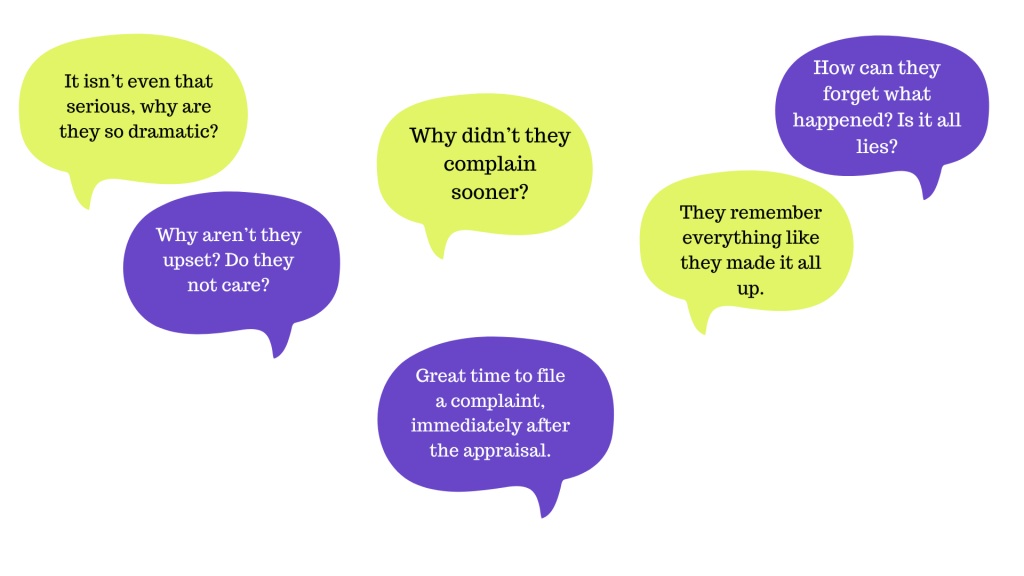We’ve all grown up with fairytales, popularised by Disney.
There’s Snow White, whose stepmother was so jealous of her beauty that she wanted Snow White dead. Snow White is banished to the woods only for her stepmother to try to murder her with a poisoned apple.
There’s also Sleeping Beauty who, for no fault of her own, was cursed by an evil witch to fall into a slumber on her sixteenth birthday after pricking her finger on a spindle.
So why am I explaining the plot to every Disney movie?
If we break these stories down, they all have one clear villain and one clear hero. The hero does absolutely nothing to bring the wrath of the villain onto themselves and reacts graciously and immediately to the wrongdoings of the villain.
But what happens when we bring the fairytale world to sexual harassment in the workplace?
What is the perfect victim myth?
When you hear about an incident of sexual harassment, there are so many questions that pop up in your mind about the complainant.

These ideas of how a complainant should react or behave when being sexually harassed or after an incident of sexual harassment form the basis of the perfect victim myth.
The myth consists of the idea that a victim is always traumatised and emotionally impacted by the incident of sexual harassment in a manner that is obvious to everyone, but at the same time, they still feel confident enough to immediately confront the behaviour and file a complaint of sexual harassment.
The perfect victim myth also creates an unrealistic test for who is believed about their experience of sexual harassment and who isn’t.
Why is the perfect victim myth a myth?
If you look at the core ideas of the Perfect Victim and the statements and questions that come up, they can contradict each other.
The perfect victim is confident in confrontation, filing a complaint of sexual harassment and recollecting the incident perfectly but not showing enough emotions create doubt about whether the complaint is genuine.
The Perfect Victim is a myth because they cannot exist and are a figment of our collective biases about who faces sexual harassment and how people who face sexual harassment behave.
Different people have different reactions to threats and sometimes, there can be very real pressures- especially in the workplace, about how safe it is to confront sexual harassment.
When we get to the workplace, there are so many different challenges for a complainant in terms of actually filing a complaint of sexual harassment. Lack of awareness, fear of retaliation and the impact of the culture surrounding sexual harassment can severely impact if people reach out to file complaints of sexual harassment.
How do you circumvent the perfect victim myth?
Don’t put yourself in someone else’s shoes. Our first reaction to any experience is to think “What would I do if this happened to me?”
When you put yourself in someone’s shoes, you’re thinking about how you would hypothetically react in a scenario based on how you understand it.
This also means removing the person facing sexual harassment from the centre of the conversation and by doing that, we erase their social identity, their experience of power dynamics and the very real threats that they may face.
One of the very basics of sexual harassment laws is the impact of sexual harassment on the complainant. Something that putting yourself in their shoes erases.
Instead of trying to understand their reaction to the sexual harassment from your own point of view, focus on what the complainant has shared about the incident. Focus on the evidence being presented and the facts.
Confront your biases
The perfect victim myth is just different forms of biases coming together.
To effectively circumvent the perfect victim myth, it is essential that we recognise the biases that we may have – about complainants, sexual harassment, gender, the workplace and even about ourselves. The first step to confronting biases is to be aware of them.
To identify your biases, spend time learning and reading about sexual harassment and unconscious biases. This will help you understand how they can present when you are faced with the situation.


